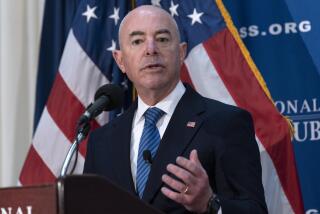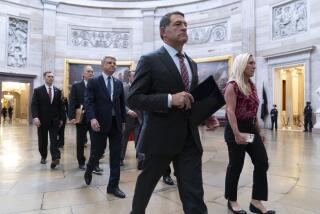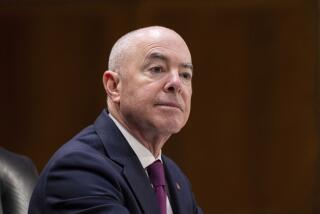Senate Trial of Clinton Opens
WASHINGTON — The impeachment trial of President Clinton opened in the Senate on Thursday with choreographed precision that began a day of intense political maneuvering and rampant confusion over how to conduct the proceeding.
At the end of the tumultuous day, Republicans and Democrats declared a truce and agreed to convene an extraordinary private meeting of all 100 senators this morning in hopes of crafting a bipartisan blueprint to govern the second presidential impeachment trial in U.S. history.
The session was announced Thursday evening by Senate Majority Leader Trent Lott (R-Miss.) and Senate Minority Leader Tom Daschle (D-S.D.) at a joint press conference in which both candidly acknowledged their failure thus far to forge a consensus in a deeply divided Senate.
“Sen. Daschle and I are not dictators. We are leaders . . . we have to bring along 98 other senators. We are struggling very hard to do that,” Lott said. “We’re asking the indulgence of the American people.”
Even as the trial opened, Republicans and Democrats were at loggerheads over such fundamental issues as its duration and whether witnesses should be called.
That the Senate still was unable to agree on how to conduct the trial--almost three weeks after the House voted to impeach the president--underscores the political dilemma lawmakers face.
Many believe that it is their constitutional duty to follow through with a process that is perhaps more grave than anything--short of declaring war. Yet they know all too well that the American public has consistently registered an overwhelming desire for Congress to deal expeditiously with the controversy, without removing Clinton from office.
Clinton was impeached on Dec. 19 by the House of Representatives, which approved two articles of impeachment charging him with perjury and obstruction of justice in trying to conceal an affair with former White House intern Monica S. Lewinsky.
The trial’s solemn opening day began on a subtle note of partisanship as Vice President Al Gore spurned his constitutional prerogative by not showing up to preside, as he usually does at momentous Senate events.
Instead, the job of gaveling the Senate to order fell to Sen. Strom Thurmond (R-S.C.), the 96-year-old Senate president pro tem.
A few minutes after 10 a.m., Rep. Henry J. Hyde of Illinois, leader of a 13-member House GOP team that will present the case against Clinton, entered through the chamber’s back double-doors.
In measured half-steps, the chairman of the Judiciary Committee walked down the sloping center aisle, followed in a single file by the 12 assistant “managers”--all of them Republican members of his committee. It is their job to persuade at least 67 senators to remove Clinton from office.
In a straightforward monotone that belied the drama of the moment--not seen since the impeachment trial of President Andrew Johnson 131 years ago--Hyde took about 10 minutes to read the articles of impeachment.
Senators Sit Mute During Presentation
Standing at a movable lectern positioned in the well of the Senate, while his co-prosecutors arranged themselves before him in a semicircle--ironically, on the Democratic side of the chamber--Hyde issued a sobering indictment of the nation’s 42nd president.
Clinton, Hyde informed the Senate, “has undermined the integrity of his office, has brought disrepute on the presidency, has betrayed his trust as president and has acted in a manner subversive of the rule of law and justice, to the manifest injury of the people of the United States.”
During Hyde’s presentation, most senators sat mute at their mahogany desks. Many wore serious and, in some cases, glum expressions.
“I was sad,” Sen. Byron L. Dorgan (D-N.D.) said later. “Sitting there today . . . it was kind of a foreboding thing to think that the coming weeks we’re going to spend our time in an impeachment trial.”
When Hyde finished, most senators stood silently at their desks as the House lawmakers exited. From his back-row seat at the aisle, Sen. Daniel Patrick Moynihan (D-N.Y.) shook hands with each Republican House member as they passed. The Senate then adjourned until shortly before 1 p.m.
At 1:20 p.m., six senators (three Republicans and three Democrats) escorted into the chamber U.S. Chief Justice William H. Rehnquist, who strode quickly to the presiding officer’s desk, his ceremonial black robe flapping in his wake.
There, Thurmond administered to Rehnquist the oath of office as the trial’s presiding officer.
Immediately after that, senators stood collectively as Rehnquist administered to them their oaths as jurors.
Rituals End With Roll Call
In the trial, the 91 men and nine women will have the power either to acquit the president or become the first senators in American history to fire a chief executive for “high crimes and misdemeanors.”
The rituals ended with a formal roll call, in alphabetical order, with each senator standing to reaffirm his or her oath with a simple: “I do.”
One by one, they then lined up to sign a trial log attesting to their commitment to “do impartial justice,” using separate pens embossed with the words “United States Senate” that they got to keep as souvenirs.
In one of the oddities of the day’s ceremonial rites, James W. Ziglar, the Senate sergeant-at-arms, twice warned one and all in the press and visitors galleries to “keep silent, on pain of imprisonment” during the proceedings.
Sen. Barbara Boxer (D-Calif.) nearly missed her oath. Fighting the flu, she grew faint during a midday meeting and had to go to the Capitol physician’s office. But she recovered in time to get to the floor for the swearing-in ceremony.
As dawn broke over the Capitol on Thursday, there were signs that some agreement on how to conduct the trial might be in the offing.
During negotiations with senators of both parties the night before, White House lawyers sought a truncated trial with no witnesses. In exchange, they offered, the president would stipulate to all the evidence from the investigation of independent counsel Kenneth W. Starr.
But by midmorning, it was clear that Republicans, who hold a 55-45 majority in the Senate, were united behind a plan by Lott to hold a trial of several weeks’ duration that would include testimony from key witnesses.
Democrats, furious because they believed their GOP colleagues were doing the bidding of the more partisan House Republicans, were prepared to go to battle.
At that point, Lott suggested an all-senators’ session to discuss how to proceed. But Democrats did not take him up on the offer, which Republicans then portrayed as a partisan rebuff.
The bipartisan group that had been trying to work out an agreement then dissolved amid recriminations.
Midafternoon, Lott scheduled a 5 p.m. Senate vote, at which time Republicans appeared poised to ram through their own trial blueprint.
That plan, as later revised, called for opening arguments on Wednesday and allowed each side 24 hours to present its case. Senators would have up to 16 hours to question the presenters.
After that, according to the plan, witnesses could be called if a majority of the Senate agreed. Although no time limit was fixed, Republicans said they hoped the trial could end as early as Feb. 5.
Under the GOP plan, Democrats would have the ability at any time during the trial to offer motions that would cut it short, either by adjourning or moving directly to a vote on the articles of impeachment.
But the impending afternoon vote touched off another round of frantic meetings. Many Republicans urged Lott to delay the vote, arguing that it would almost certainly lead to a straight party-line tally, thus allowing Democrats to portray the trial as a partisan effort by Republicans to oust a Democratic president.
“We need to bend over backward to show we’ve done everything we can to be bipartisan,” said Sen. Sam Brownback (R-Kan.). “It’s a compelling political strategy on their side,” he said of the Democrats.
By day’s end, Lott and Daschle reached an agreement to postpone the vote on trial procedure and convene all senators at 9:30 a.m. today.
“We think that the best way to keep calm and cool and dignified is to look at each other and talk to each other,” Lott said. “You know, we are in uncharted waters. There are some precedents, but there are many questions that we’re having to address that are different from what has ever been addressed before in history.”
Both leaders acknowledged that big differences remain between the parties on whether to call witnesses and said this morning’s meeting may end up doing little more than make senators feel better because they gave bipartisanship one more college try.
But Lott added optimistically: “We may be closer than we might think.”
Late Thursday night, Daschle made a counterproposal to the GOP plan. Democrats would like the opening arguments to begin Jan. 12 and have the trial end Jan. 26.
Such a schedule could cause a postponement of Clinton’s annual State of the Union address, now planned for Jan. 19.
Under the Democratic plan, Hyde and his managers would have two days to present their case, as would White House lawyers. That would be followed by two days of questioning by senators, who must submit their queries in writing to Rehnquist.
The Democratic plan would provide one day for closing arguments, with each side getting three hours, plus a final, additional hour for the prosecutors.
Deliberations would commence the following day and conclude on Jan. 25. The next day, the Senate would vote on the articles of impeachment.
GOP Seen Wanting Democratic Support
The White House interpreted the roller-coaster day on Capitol Hill as a sign that Senate Republicans are loathe to adopt trial procedures without some Democratic support.
“I think they don’t want this to be seen this way,” White House spokesman Joe Lockhart said. “They’re going to try to work it out. But will they be able to? I don’t know. Not if the House guys have anything to do with it.”
Even as Lockhart spoke, Hyde and his prosecution team spent much of the day devising trial strategy and drawing up a witness list.
Rep. Ed Bryant (R-Tenn.) said the House managers hope to call about a dozen witnesses, including Lewinsky, presidential secretary Betty Currie, Clinton confidant Vernon E. Jordan Jr., a variety of top presidential advisors and experts in the areas of perjury and sexual harassment.
But the White House responded negatively to the prospect of any witnesses being called.
“As soon as you introduce the concept of witnesses, it’s terribly hard to limit them and remain fair,” Lockhart said.
“If we’re required to go through a full-blown trial, then we’ll do so reluctantly but successfully,” added one of the president’s senior advisors, who spoke on the condition that he not be identified by name.
Times staff writers Marc Lacey, Richard A. Serrano and Elizabeth Shogren contributed to this story.
You can easily let your elected representatives in Washington know your views on the impeachment process with the “Write to Congress” feature on The Times’ Web site:
http://vinapk.com/scandal
(BEGIN TEXT OF INFOBOX / INFOGRAPHIC)
WHAT 2 SIDES WANT
Key elements in battle over Senate trial rules:
Dems.:
GOP:
Arguments begin
Dems.: Jan. 12
GOP: Jan. 13
****
Witnesess
Dems.: No
GOP: Yes*
****
House to present case
Dems.: 2 days
GOP: 24 hours**
****
White House to present case
Dems.: 2 days
GOP: 24 hours
****
Senate questions
Dems.: 2 days
GOP: 16 hours
****
Closing arguments
Dems.: 7 hours
GOP: 16 hours
* Majority vote required to call each witness
** GOP plan doesn’t specify the number of days these hours could span
(BEGIN TEXT OF INFOBOX / INFOGRAPHIC)
Senate Impeachment Oath
The oath administered to members of the U.S. Senate and the presiding officer sitting in the impeachment trial of President Clinton is taken from “Riddick’s Senate Procedure,” a handbook on Senate practices. The oath is required under the Constitution.
More to Read
Get the L.A. Times Politics newsletter
Deeply reported insights into legislation, politics and policy from Sacramento, Washington and beyond. In your inbox three times per week.
You may occasionally receive promotional content from the Los Angeles Times.











